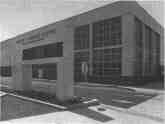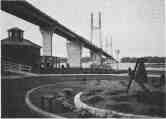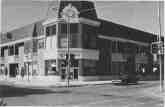Quincy's Central Business District "Rolling On The River"
By ROBERT B. TESKA, President, Teska Associates, Inc., Evanston
Few small cities in mid-America can claim as illustrious a past, as exciting a present, and as promising a future as Quincy. A major commercial center on the Mississippi River in the 19th century, the city still exhibits a collection of historic buildings that is among the best in mid-America. However, Quincy's relative inaccessibility via rail and highway, especially since World War II, paralleled a 30-year period of economic and population decline experienced throughout the Mississippi Valley. Today, that is history, thanks to civic leaders who took the bull by the horns in the 1980s and turned things around, initiating a renaissance in the Central Business District (CBD).
 Oakley-Lindsay Civic and Performing Arts Center
Oakley-Lindsay Civic and Performing Arts Center
A joint public-private effort begun in the early 1980s led to a tax increment redevelopment project producing (in 1984) a new Holidome Hotel and conference facility one block from historic Washington Park and (in 1995) the new Oakley-Lindsay Civic and Performing Arts Center. The spectacular Bay View
 Clat Adams Bicentennial (riverfront) Park
Clat Adams Bicentennial (riverfront) Park
Bridge leading to Missouri was completed in 1987 and in its shadow the new Clat Adams Bicentennial (river-front) Park was built in 1992, where a former stock-yards had stood. A new City Hall opened the same year.
All of America and much of the world knows what happened in 1993 - the great Mississippi River flood. Fortunately, Quincy itself suffered little and became the base of operations for relief to a vast region of devastation. But that is only part of the story.
That same year (1993) the City of Quincy, with financial assistance from private contributors, began the process of comprehensive planning for its large (80 block) Central Business District, which lacked a strategic plan for revitalization beyond the TIF project. A report prepared by consultants, entitled "POSSIBILITIES," contained a simple but fundamentally strategic CBD development concept and over 50 specific recommendations for initiating a coordinated revitalization effort. Virtually all were completed or initiated. The most important of these was to appoint the Great River Economic Development Foundation (a county-wide public-private agency which heretofore focused
October 1996 / Illinois Municipal Review / Page 11
 Maine Center retail complex
Maine Center retail complex
primarily on industrial development) as the coordinator of numerous independent organizations, including Uptown Quincy and the City. By 1995 one-way streets were converted to two-way traffic, a 20,000 sq. ft., two-story, mixed-use retail complex (Maine Center) was constructed at the 100% corner, the Pier restaurant was opened (cantilevered over the river), the Adams County Building was renovated, the QMG Clinic was opened, and several other projects were announced -reflecting new confidence in the city and its CBD.
In 1995 the Great River Economic Development Foundation engaged consultants again to complete work on a detailed comprehensive plan and program for all of the CBD entitled, "RECOMMENDED ACTIONS," and adopted in 1996 by the City Council as an element of the City's Comprehensive Plan. Currently, public parking lots and streetscapes are being enhanced, at least six private redevelopment or adaptive reuse projects are underway (some with city assistance), a business and developer recruitment program has been initiated, and a marketing and public information program is underway with assistance from the local news media (the Herald-Whig newspaper, plus radio and TV stations). The Quincy Society of the Fine Arts, first of its kind in the U.S., has taken responsibility for implementing a key recommendation of the CBD plan - an eight-block long Corridor of the Arts.
Between 1990 and 1995 population decline has reversed itself, and Adams County grew from 66,090 residents to over 68,000 residents. The Quincy market area, which exceeds 250,000 residents, has grown proportionately. Commercial and industrial development throughout the city is accelerating, and the City has become a major destination for national and world specialty conventions.
Clearly, Quincy and its CBD are on a roll, taking advantage of the nation's strong economy, but succeeding primarily because of inspired leadership, coordinated resources, a plan endorsed by all key parties, and a committed community. Quincy can realistically be considered a model for other mid-American communities.
For further information contact James E. Mentesti, President, Great River Economic Development Foundation (217/223-4313). •
Page 12 / Illinois Municipal Review / October 1996